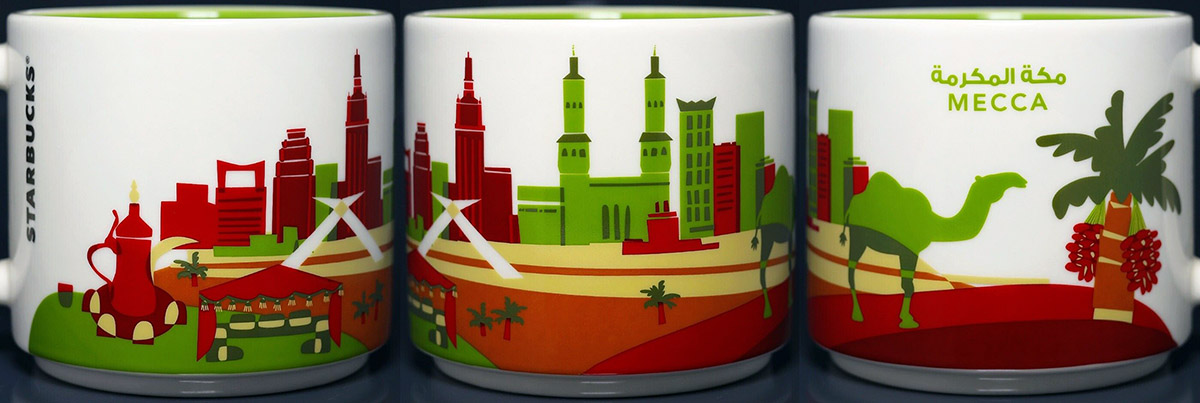
You Are Here – Mecca
You Are Here – Mecca is an unexpected release from Saudi Arabia. Mecca (officially Makkah al-Mukarramah) is generally considered the holiest city in Islam and holds immense significance in the Muslim world. It is the birthplace of the Prophet Muhammad and the site of the Kaaba, the most sacred structure in Islam, towards which Muslims around the globe face during their daily prayers. Every year, millions of Muslims undertake the pilgrimage known as Hajj, which is one of the Five Pillars of Islam, to Mecca. This pilgrimage, required at least once in the lifetime of every able-bodied Muslim, symbolizes unity, equality, and submission to Allah. The city’s spiritual and historical importance makes it a focal point of devotion, reverence, and communal identity in the Muslim world.
Interestingly enough, along with the Romanized name Mecca, designers included the city’s official name, Makkah al-Mukarramah, written in Arabic. We’ve seen this before in the case of the Saudi National Day mug.
As for the overall design of the Mecca mugs, these are the symbols and landmarks of Mecca that were included:
– The camel, often referred to as the “ship of the desert,” is a symbol of resilience and endurance in the harsh conditions of the Arabian Peninsula. In Mecca, camels have historically been vital for transportation and trade, enabling the flow of goods and pilgrims across vast desert landscapes. The inclusion of a camel on the Mecca coffee mug reflects not only the animal’s importance in the region’s past but also its enduring presence as a symbol of the deep connection between the people and their environment.
– The palm tree, especially the date palm, is synonymous with life and sustenance in the Arabian Peninsula. In Mecca, these trees have provided shade, food, and materials for centuries, making them an integral part of the city’s daily life and economy.
– Qahwa, or Arabian coffee, is a traditional and culturally significant beverage in Mecca and across the Arabian Peninsula. Made from lightly roasted coffee beans and often flavored with cardamom, saffron, or cloves, qahwa is known for its unique and aromatic taste. It is usually served in small, handle-less cups called finjan, accompanied by dates or other sweets. Qahwa holds a special place in the social and cultural life of Mecca, symbolizing hospitality and respect. Offering qahwa to guests is a cherished custom, reflecting the warmth and generosity that are central to Arabian and Islamic traditions. The ritual of preparing and serving qahwa is often done with great care and attention, making it more than just a drink, but a meaningful expression of the region’s rich cultural heritage.
We can also see Mecca’s skyline, which is a unique blend of ancient and modern architecture, reflecting its spiritual significance and rapid development. You probably heard about these two architectural landmarks:
– Masjid al-Haram: At the heart of Mecca’s skyline is Masjid al-Haram, the largest mosque in the world and the holiest site in Islam. It houses the Kaaba, the sacred cube-shaped structure that Muslims face during prayer. The mosque’s sprawling complex, with its tall minarets and expansive prayer halls, dominates the skyline, symbolizing the city’s central role in the Muslim world.
– Abraj Al Bait (Clock Tower): One of the most striking features of Mecca’s modern skyline is the Abraj Al Bait, a complex of seven skyscraper hotels, topped by the iconic Clock Tower. This tower is one of the tallest buildings in the world and features the largest clock face. Visible from miles away, the Clock Tower serves as a beacon for pilgrims and a symbol of Mecca’s modern development. The tower also houses the Makkah Royal Clock Tower Museum, offering visitors a unique perspective on timekeeping and Islamic history.




































































